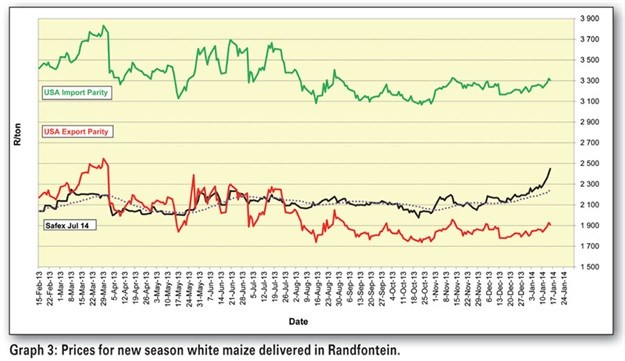Relying on imports to feed the nation
The World Meteorological Organisation has referred to the ongoing El Niño as the strongest experienced in 15 years. Responsible for heavy rains in South America and forest fires in Indonesia, it has resulted in far below-average rainfall, and very high temperatures in Southern Africa adversely affecting agriculture in the region.
The Famine Early Warning Systems Network expects 'stressed' and 'crisis' outcomes between January and March in the broader Southern Africa region: "Poor households in these areas will experience livelihood protection and consumption deficits due to reduced casual labour opportunities, above average food prices, poor pasture and livestock conditions, the late start of season, and poor rainfall performance so far."
We interviewed Professor in Food Security Sheryl Hendriks from the University of Pretoria on the possibility of a food shortage in SA, and how South Africans should be preparing for the rising cost of food.
With SA now having to import six million tonnes of maize, will it be enough to quell a potential food shortage?
At this point, we are not sure how much we will need to import. The difficulty is that our exchange rate makes imports exceptionally expensive.

|
The cost of local production is far lower than the cost of importing - especially when international demand and prices are high, but more so because our exchange rate has weakened so drastically.
Maize meal prices have already increased in the stores. The price of SA's staple food will increase dramatically when we start importing as the consumer will need to cover the costs of importation. If the drought continues, we will face future shortages, making us reliant on imports in the near-term.
The current crisis affects white maize more than yellow maize. Yellow maize is used for animal feed so the white maize crisis will affect the price of mielie meal and other foods where maize is added - corn flour, baking goods, biscuits, breakfast cereals etc.
One of SA's best options would be to turn to consuming yellow maize, as we did in the crisis in the 1980's when we were faced with a similar crisis. One could only buy yellow maize because sanctions prevented us from importing white maize from other countries. Not many countries produce white maize in surplus except for the US, Mexico, Brazil and China. Although, using yellow maize for human consumption would exacerbate the shortage of supply of animal feed, which would affect the prices of other foods such as meat, chicken and dairy products.
According to World Vision's Paula Barnard, if we don't have adequate rain by March / April 2016, this could spell disaster for SA. What does the worst-case scenario look like?
The worst case is white maize will be unaffordable - especially for the poor. Even a small price increase affects poorer consumers. Maize is the staple (and in many cases the only) food consumed by poor households. Apart from taste preferences, there are not many alternatives as sorghum is also in short supply due to the drought. A large proportion of wheat is imported as well and so bread is not an alternative to maize for poorer consumers. Vegetables too are badly affected by the drought and prices of other starches such as potatoes and sweet potatoes are astronomical at the moment. Making yellow maize available to consumers immediately is quite important and necessary. It will provide an alternative to those prepared to switch consumption from white to yellow maize meal!
Is the South African government prepared for such a disaster? Do we have contingency plans in place?
The current government has not had to deal with a drought or food crisis of this proportion. The severity and scale of this drought is exceptional. Most of the country is affected and so we are not able to support one area by bringing supplies in from another area. We do not have national reserves to deal with a crisis of this proportion. A number of national crises such as electricity shortages have led to redirecting of national reserves to solve other problems.
What should South Africans - at various income levels - be doing at this stage to prepare for impending food price increases, as well as food shortages?
Be prepared to make changes to your diet - even if this means switching from white to yellow maize. It is healthier for you anyway as it is packed with vitamins and minerals. Each household needs a contingency plan. While hoarding supplies for the future may not be feasible due to inadequate storage facilities and the perishability of foods, consumers should be either putting money aside for possible emergencies or storing non-perishable foods for times of hardship. For middle-income families, there are a number of health substitutions that can be made to reduce the cost of meals without reducing the nutritional value of meals such as adding lentils, beans and pulses to meat dishes or substituting pulses for meat, as well as eating porridges made of oats and sorghum rather than ready-prepared cereals and increasing the consumption of vegetables. Taking lunch to school and work is another option that saves costs and provides a more healthy meal.
For lower-income and poor consumers who consume mainly pap, the options are limited. These consumers will most likely need support from relatives or government if the price of maize meal increases substantially.
For all, avoiding debt is crucial!
 |
News Category
- International retailers
- On the move
- Awards and achievements
- Legislation
- Wine and liquor
- Africa
- Going green
- Supplier news
- Research tools
- Retailer trading results
- Supply chain
- Innovation and technology
- Economic factors
- Crime and security
- Store Openings
- Marketing and Promotions
- Social Responsibility
- Brand Press Office
Related Articles

Empowering South African households through gro...
South Africans are resilient people who are always ready to seek solutions for problems, even if the trials they face are caused by events that are beyond their control. An empowering example of this approach to life is the use of grocery stokvels...

SPAR shares practical tips to beat food inflation
In response to rising food costs, The SPAR Group offers practical tips for beating food inflation through savvy shopping and creative cooking.

South African motorists could be paying up to R...
By: Myles Illidge – MyBroadband
South Africa’s Road Accident Fund (RAF) tax and General Fuel Levy (GFL) add between R272 and R483 to the price of a tank of fuel, depending on the size of your car’s tank.

Big VAT changes on the cards
By: Shaun Jacobs – Daily Investor
Major changes are coming to VAT in South Africa, with the government looking to expand the range of food items exempt from the tax.

Good signs for petrol prices in South Africa
By: Hanno Labuschagne - MyBroadband
An anticipated strengthening of the rand and slipping global oil prices could result in lower petrol prices at the pumps next month.

